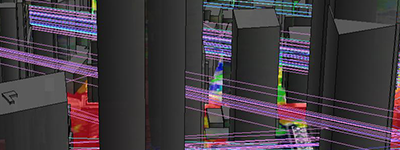The Challenge of Accuracy vs Speed
When running studies, especially those that cover large regions, we have become used to trading speed for accuracy. With the Grid Optimized Radials calculation method in EDX RF Planning software, this is no longer the case. Grid Optimized Radials is an automatic calculation that produces optimal radial lines to give you the best prediction accuracy – extending all the way to study boundaries even for very large service areas.
When thinking of RF coverage analysis in layers, we know there would be a layer of GIS data made of terrain elevation and land use data, then the layer of radial lines from the transmitters, then the study grid that you define. This is the “radial line method” style of coverage analysis.
In traditional wireless network planning software, engineers have the choice between this radial line method and the direct to grid method, which will extract data from each point in the study grid offering a higher level of accuracy. Of course the trade-off by utilizing the direct to grid method is it takes significantly longer to run the study.
The Solution
With EDX’s novel Grid Optimized Radial method, the radial density automatically increases as the study points get further from the transmitter, thereby increasing the prediction accuracy at longer distances but it also minimizes the impact of increased computation time.
This calculation method solves the problem of accuracy vs speed in the most practical way while providing the most beneficial information. Because whether you use radial line or direct to grid, the predictions will always be accurate near a transmitter. It’s at the edges of a network, particularly for larger service areas, where it becomes critical to see higher resolution study results and where we’re going to have to provide these answers for customers and deliverables.
As such, the accuracy improvements in the program here will also keep you more productive in that the program makes these calculations efficiently. Perhaps more importantly, your deliverables are improving because of the enhancements to the accuracy at long distances.
The Results
The graph below depicts the absolute error in the prediction for the Grid Optimized Radials method versus traditional calculation methods. You can see as we move further from the transmitter, the new Grid Optimized Radials is giving us more accurate results.

The overall picture shows us that using the traditional method, the further we get from the transmitter, the more inaccurate our model becomes; whereas using the Grid Optimized Radials method, the average absolute error is more or less the same no matter how far away we are. With this calculate, you are provided a much more detailed, resolute and realistic picture of coverage, particularly at the system edge.







